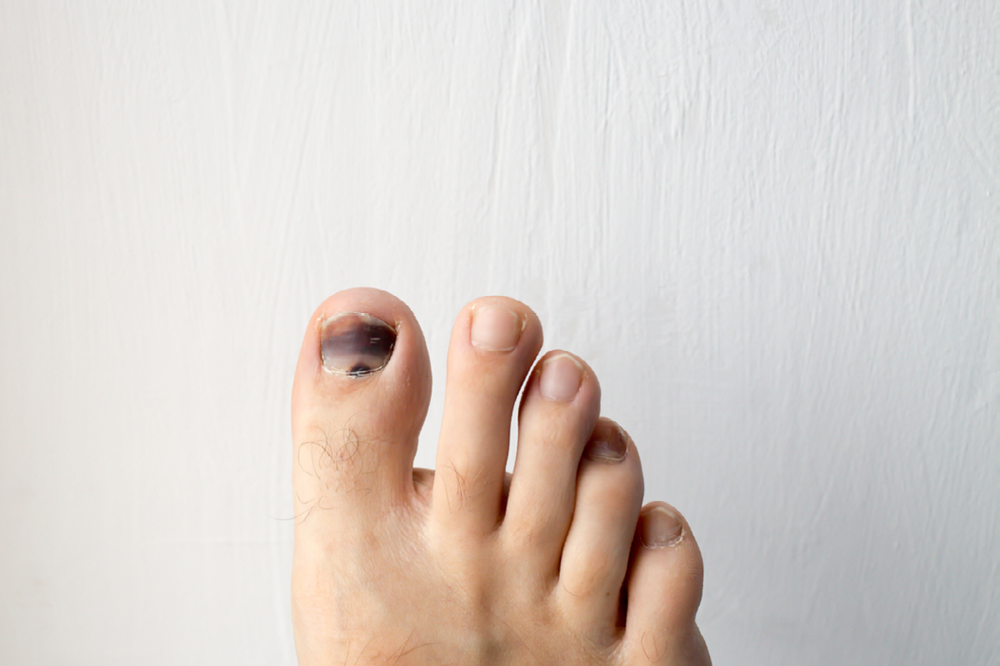If you look down at your feet and think of the movie Meet Toe Black, then you’ve got a serious case of black toenail that needs clearing up. Often caused by trauma, fungus or repeated injuries that create a collection of thickened blood under the nail (otherwise known as a subungual hemotoma), black and discolored toenails can be painful as well as embarrassing.
What Is a Black Toenail and What Causes the Discoloration?
Toenails can change colors for a variety of reasons, but when the discoloration is black, red, deep purple or burgundy, it’s often due to trauma or repetitive irritation that results in a thickened pool of blood underneath the nail — essentially, it’s a bruise. Black toenails typically develop from repeated injury, such as a toenail bumping into the tip of your shoes over and over again (a common running injury). But sometimes, the condition can be created from sudden crush injuries, like dropping a heavy item on the nail or stubbing your toe on a hard surface. In some cases, black toenails can be caused by fungal infections, which have the ability to darken the keratin tissue under the nail, or by ingrown toenails, which can create intense irritation to the nail and surrounding skin.
At-Home Podiatrist: Symptoms of Black Toenail

MORE FROM FOOTFILES:
Black toenail is characterized by a discoloration of the nail (usually black, dark red, purple or burgundy) that is often coupled with a throbbing pain generated by the pressure of the thickened blood collecting between the nail and the nail bed. Sometimes you’ll notice discharge and an unpleasant smell.
If a severe blow, crush or other type of serious toe injury caused your black toenail, seek immediate medical attention. In addition to the subungual hematoma, you could have broken bones or other critical damage that could prevent you from walking or doing other daily activities.
If you have black, red or purple discoloration to the toenail and no history of an injury, you should have the nail evaluated by your health care provider. The change in color could be caused by fungus, which will need to be treated with anti-fungal medication. In rare cases, the discoloration is caused by a malignant melanoma tumor. A simple way to assess whether or not the change in color is caused by a tumor is by observing the nail growth: Subungual hematoma will grow out with the nail, while a tumor will stay in the same spot.
Black Toenail Treatment and How Long To Wait For Regrowth
If your subungual hematoma is small or painless, then treatment of the nail is usually unnecessary. The discolored area will simply grow out as your nail grows and could be gone in just a couple of months. In rare instances, the pooled blood will separate the nail from the nail bed and the toenail will simply fall off. If this happens, you can expect a new toenail to fully regrow in about six months. However, regrowth may be delayed if there has been injury to the nail bed.
If the pressure created by the pool of blood becomes too intense, your health care provider can offer a couple of different decompression methods to drain the blood, which reduces the pressure and the pain. After numbing the area, your doctor can either use a heated wire or carbon laser to burn a hole in the nail, or he or she can use a needle to perforate the nail. You’ll then have to bandage the treated nail for several days and keep your foot elevated. Podiatrists urge patients not to try draining the nail at home; DIY procedures are often unsanitary, not to mention painful.
RELATED: A Quick Cure For Brittle Nails
If your black toenail is serious or if the discoloration affects a large portion of the nail, your health care provider may recommend nail removal and stitches to the nail bed in order to prevent infection and other complications.
In all subungual hematoma cases, there is a possibility that the nail will never return to its normal appearance. Be sure to visit your health care provider if you notice any discoloration as the nail regrows.
Editor's Note: While it may be tempting to try and hide black toenails with nail polish, it is strongly advised that you avoid the temptation. Painting the nail doesn't allow air to circulate and could lead to loss of the nail altogher if something like fungus is to blame for the condition.
How To Prevent Black Toenails

- Whether you already have a black toenail or if you’d like to prevent the painful discoloration, be sure to wear properly fitted shoes that leave ample room in the toe area. Also be sure to choose footwear that will protect your toes from accidental injury, such as heavy objects falling on your feet.
- Keep your toenails properly trimmed in a straight across line to prevent ingrown toenails, which can also cause subungual hematoma.
- Be sure to keep your feet clean, dry and moisture balanced at all times. Doing so can help prevent fungal infections and other conditions that could lead to black toenails.
- Treat any nail conditions in their early stages to avoid complications and worsening of the problem.
If you're trying to grow out your black nails, you can follow these 10 tips for growing healthy toenails. And if your black spot is caused by a fungal infection, check out these effective home remedies for toenail fungus.


